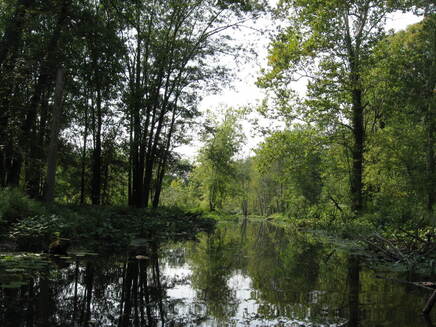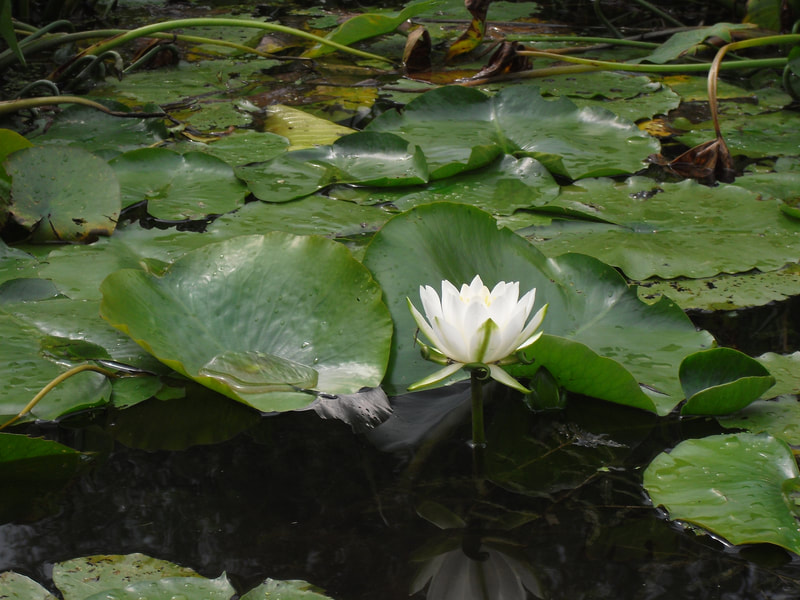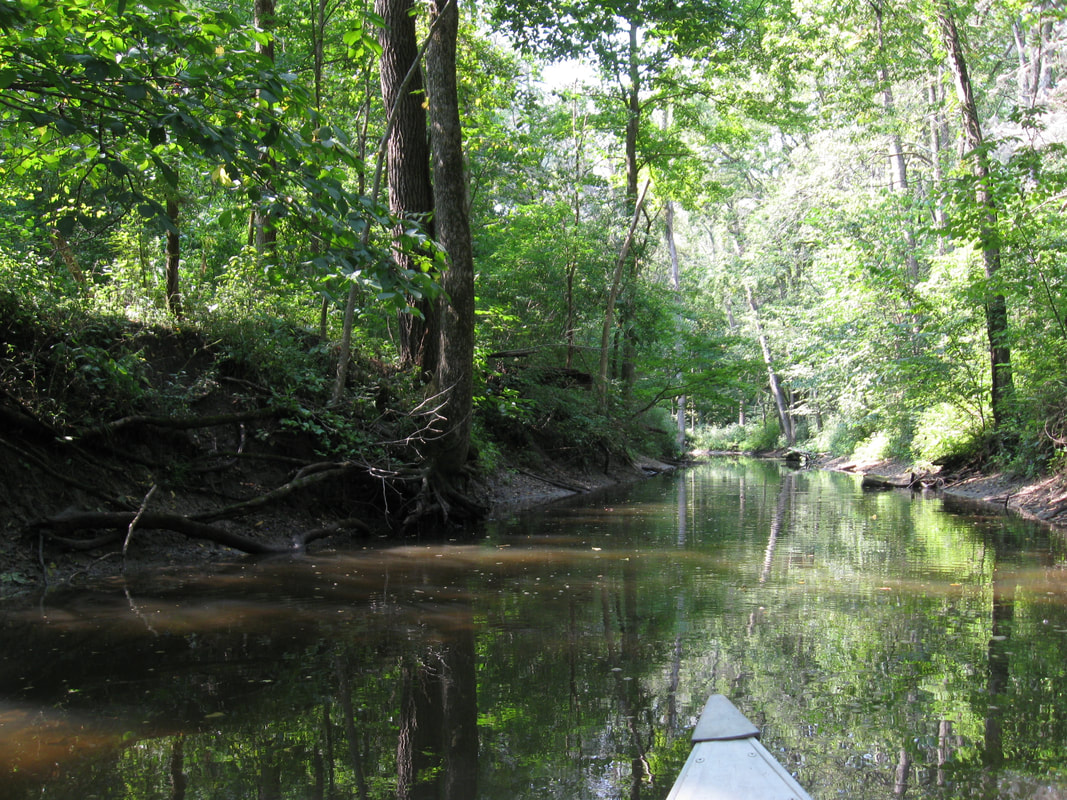Among low wooded hills nestles a series of lakes, linked in a series by still-water channels. Passage from one lake to another can be quite constricted, with close-hugging banks or a narrow path through lily pads. Still, travel by boat offers easier and quieter progress than by bushwhacking the irregular forested slopes on foot.
Dimensions The lakes are hundreds of yards/meters across, the whole chain spanning 2.5 miles (4 kilometers) of the terrain. Parts of the lakes exceed 30 ft (15 m) in depth. Open channels between lakes are typically 10-20 feet (3-6 m) wide and 2-4 feet (0.6-1.2 m) deep. Each one winds for a significant distance, 0.1-0.6 miles (0.2-1.0 km).
Key Details
- The land is fully forested. View of the sky is patchy when inland, half obscured when on a lake's edge, and clear in all directions only when well out from shore.
- Placement of hills, low areas, channels and lakes is quite random in this region. Land travel through the woods is confusing, with no consistent layout of slopes or other pattern to the terrain.
- Origin: When these hills were piled up at the front edge of a continental ice sheet, some huge blocks of ice were buried in the thick deposits of rock and soil debris. As the ice blocks gradually melted, the ground above sank down, adding to the randomness of this pockmarked terrain. The great depressions among the hills filled with rainwater, which eventually overflowed across low points to join one lake to another.
- When seen from above, the lakes are rounded in form, their smooth shores lacking points and inlets. Standing at about any location on a lake's shore, it is possible to survey the entire water surface and most of the shoreline, excepting some spots on the nearest side of the lake.
- Many parts of a lake's shore are low-sloping: easy places to land boats or for swimmers to leave the water. However, on close approach, reaching dry ground may require maneuvering through a patch of lily pads, reeds, or floating logs.
- Turkey vultures are often seen perching on bare tree tops and wheeling in the sky. In warm weather, turtles sun themselves on logs near the shore, dragonflies hover in the air, fish and minnows chase through the water, and tiny water strider bugs skate across its surface.
- Water flow is very minor in the channels between these lakes, even when weather has been rainy. Current is barely perceptible, a couple of inches (few centimeters) per minute. It is exactly as easy to guide a boat in either direction, upstream or downstream.
- In some places along a channel the soil banks to either side can be quite steep, rising a few feet/meters above water level. In other places the forest floor's edge stands barely above the water surface. In many channel locations, true dry ground is many yards/meters beyond the navigable open waterway, across a shallower water zone covered by lilly pads or brushy vegetation.

- While broad patches of lily pads do little to obscure view of what the land/water looks like beyond them, some wet areas have tall reeds, cattails, and other high-rising plants that block the view forward for anyone wading or boating through their shallows. It is often hard to perceive from a distance where the water ends and dry land begins.
- The entrance to a channel can be difficult to locate by scanning across a lake's open water. Masses of low greenery hide the narrow strip of clear water heading into the woods, until a seeker has the chance to look from just the right angle nearby. Tree cover close to the water's edge can obscure a boat occupant's broader sense of where the valley bottoms are, leading to and from a lake.
- In some channel sections, tall trees stand right on the banks, their roots partly undercut and their trunks slightly bowed over the water. Some of these mature trees have died, threatening to topple into the water.
- The view down a channel-way is occasionally quite long; however channel bends are quite common, and high banks and brush can block any view of what sits in the channel just beyond.
- Submerged logs stay close to the surface, appearing at close range to interfere with boat traffic. Their presence might be hidden by lily pads or floating autumn leaves.

- An area with scattered lily pads on the water can have dense growth of lake weed below the surface. This might more effectively hamper the progress of someone wading or swimming. Disturbing this mass might start a chain reaction, causing minnows to scatter away beneath the water, and startle fish to disturb the surface in more distant, seemingly unrelated places.
- The breeze cannot kick up very large waves on these small lakes, though windy weather might directly impede progress of boats attempting to cross. Dense growth of water plants around channel mouths diminishes any waves or ripples arriving from the lakes. The channels - shielded beneath tree cover and lacking perceptible current - often have glassy water surfaces, giving sharp reflections of the world above.
- A few large boulders of varying color and surface pattern are scattered across the forest floor, also appearing at some spots in the channels. Patches of soil range from loose and sandy to organic-rich and spongy to dense clay.
- Bare wood on the bases of some dead trees displays the complex tracks of insects that earlier burrowed their way just beneath the bark. Fungi of various types appear on fallen logs.
Story Elements

- This setting presents extreme contrasts in visibility. The lakes' open surfaces offer far-ranging views and no places for characters in boats to hide. Lake-margin areas of brush and water plants can provide concealment from spies looking across the water. Those navigating the channels are well-hidden from distant observation (even from above), but may themselves be unable to see the land close by beyond bends, high banks, or brush areas.
- Fog would alter the feel of this environment considerably, with sight of the shores eliminated for those out on a lake, shortened views available down channel-ways, and new obstacles fading silently into view close ahead. A layer of morning or evening mist could obscure most vision for travelers on the water (except of the sky directly above), while the air remains clear for those walking in the surrounding woods.
- A local character would know how to quickly navigate this chain of lakes and channels. They would be be conversant with the best launching and landing spots, areas of log debris accumulations in plant-covered water, and channel entrances along shorelines. A nonnative group with no map or other assistance could be in trouble.
- The movement of boats through a channel could be confounded by the toppling of several bank-edge trees into the water. A single fallen tree will pose brief delay in awkward navigation or a short portage, but many such measures might cause characters to abandon their craft. Knocking or cutting a tree down may be surprisingly easy. One bending out over the water could be at the brink of falling with a hard push, or especially unstable due to a load of wet snow or ice. People or creatures could attack the few remaining solid roots on a trees' bank side to topple it.
- Times when reflections on the water surface are perfect, could have further story consequences. An enchantment might cause a channel's surface reflection to reveal realities masked by others' illusions or invisiblity. What is that hulking form down at the next bend - an ogre standing very still, a boulder held over its head?
- A character well versed in the ways of insects might understand messages, foretellings, or maps in the insect tracks on a dead tree trunk.
- The various fungi that sprout from the area's standing and fallen deadwood remain even on logs floating in the lakes. For a well-trained eye, a particular variety of fungus might offer food, medicine, poison or visions.
- At the bases of large fallen trees, splays of broken roots make ominous silhouettes. Some also shield cavities beneath, which might give an individual shelter in a pinch. What other occupant might make a home in such a recess, possibly collecting a stash of interesting objects?
- The stalks of lily pads are tough and flexible. Plucking a water lily takes more effort than expected, unless done with a sharp knife. In the attempt to pull up a pad or flower, as much as a yard/meter of stalk will be drawn up out of the water, and a small boat might be dragged further away from the open channel in the process. These actions might reveal something that had been hidden below the surface, tangled in stalks and sunken branches. Someone without a paddle might try pulling on these stalks to move their craft.
- A group might come to ignore the floating logs passed by on their journey. Some of these forms might be predators, counting on this disregard.
- A character hiding among the water plants would need to stay very still if searchers are nearby, to avoid obvious disturbances in nearby plants. However because the disturbances will be spread over a zone several yards/meters across, observers may still need a few seconds to precisely target a fugitive.
Reference Location
Chain O' Lakes State Park, northern Indiana. Water exploration of the lake system is served by a Dept. of Natural Resources canoe and kayak livery, as well as several boat launches.
© Rice-Snows 2023
Proudly powered by Weebly















